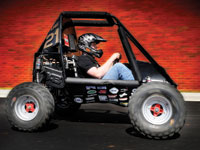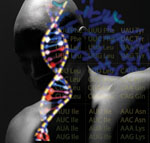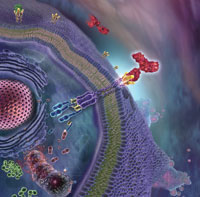Race Ready
 Each year, students from the UAB Department of Mechanical Engineering spend hundreds of hours designing and building high-tech race cars from scratch—then submit them to an off-road torture test at the international Baja SAE challenge event. The Blazer Motorsports 2010 model was its most successful ever, surpassing UAB’s previous best mark by 30 spots to finish 22nd out of 100 teams.
Each year, students from the UAB Department of Mechanical Engineering spend hundreds of hours designing and building high-tech race cars from scratch—then submit them to an off-road torture test at the international Baja SAE challenge event. The Blazer Motorsports 2010 model was its most successful ever, surpassing UAB’s previous best mark by 30 spots to finish 22nd out of 100 teams.
The annual Baja SAE competition challenges students to design and build off-road vehicles that can survive mud, jumps, and water hazards. Entries are judged in several categories, including design, cost, and endurance.
Forging Ahead
Birmingham rose to national prominence on the strength of its steel mills. Now the future of metals science could be taking shape at UAB. The School of Engineering’s new, 9,000-square-foot Metals Processing Laboratory can produce and test experimental materials on a scale virtually unmatched by other facilities around the country. The U.S. Army has contributed $1 million to support the lab, which is already testing new metals and alloys that could help make safer vehicle armor for American troops. The lab is part of UAB’s Material Processing and Applications Development Center of Excellence, which also includes the Composites Research Laboratory, making it the only academic facility of its kind in the United States.Textbooks for Sale ... or Rent
For decades, textbooks have come in two flavors—new or used. UAB’s official bookseller is now pioneering a third option. Starting this fall, the Barnes & Noble at UAB Bookstore is offering rentals for required textbooks in most undergraduate classes, or roughly 28 percent of all titles. The program is expected to save UAB students $200,000 per year.
Different Strokes
 Stroke investigators at UAB have identified new disparities in U.S. stroke rates—and helped pinpoint the optimum choice between two stroke-prevention procedures.
Stroke investigators at UAB have identified new disparities in U.S. stroke rates—and helped pinpoint the optimum choice between two stroke-prevention procedures.
A new report from UAB’s long-term Reasons for Geographic and Racial Differences in Stroke (REGARDS) study revealed that African-Americans age 65 and younger are more than twice as likely to have a stroke compared with Caucasians in any region, and people living in the South are more likely to have a stroke than people who live elsewhere. The report is among the first to show major regional and racial disparities in stroke rates. It also underscores the need for targeted stroke-prevention and care strategies, says UAB epidemiologist Virginia Howard, Ph.D., a REGARDS co-principal investigator.
UAB scientists participating in CREST, one of the largest stroke-prevention trials ever conducted, reported that patient age should be an important factor when choosing between two common procedures. Endarterectomy is a surgical procedure to clear blocked blood flow; the newer carotid stenting procedure involves threading a stent into the blocked area and expanding a small protective device to widen the blockage and capture dislodged plaques. Although the study found that both procedures are safe and equally beneficial for men and women at risk for stroke, researchers reported that stenting is better than surgery for patients age 69 and younger. For patients 70 and over, surgery is the better procedure.
 Dead Spread
Dead Spread
Killing cancer is the goal of every patient and physician. But what if death itself isn’t enough to stop cancer’s spread? That’s the question being investigated in a new UAB study funded by an $805,000 grant from the U.S. Department of Defense Breast Cancer Research Program. After breast-cancer cells are exposed to chemotherapy, they leave behind inactivated or altered DNA; UAB researchers are exploring the possibility that this genetic material may activate the spread of living cancer cells to the rest of the body. Cancer spread—or metastasis—is the number-one cause of cancer recurrence and treatment failure. If the pathway activated by dead cancer cells is found to boost metastasis, researchers can look for therapies that block or regulate the pathway, says hematologist-oncologist Katri Selander, M.D., Ph.D., co-principal researcher on the grant along with chemistry department chair David Graves, Ph.D. “This research has the potential to reach across numerous scientific disciplines and may one day improve the lives of patients worldwide,” she says.
Magic Markers
Two recent UAB discoveries underscore the promise of personalized medicine, which aims to tailor treatments to each patient’s unique needs through genetic testing and other technological advances.
Multiple Sclerosis: Researchers at UAB and Stanford University have identified a biomarker that could improve treatment for patients with multiple sclerosis (MS). Investigators found that MS patients who have different blends of certain T helper immune cells in their systems respond differently to a first-line MS therapy. Patients with a certain mixture respond well to interferon-beta, the typical first therapy. Another group—a subset of about 30 percent of patients—does not respond; in fact, interferon-beta may leave them worse off. UAB immunologist Chander Raman, Ph.D., lead investigator of the study, says it could lead to a simple blood test that eliminates guesswork and guides clinicians to the proper therapy from the beginning of treatment.